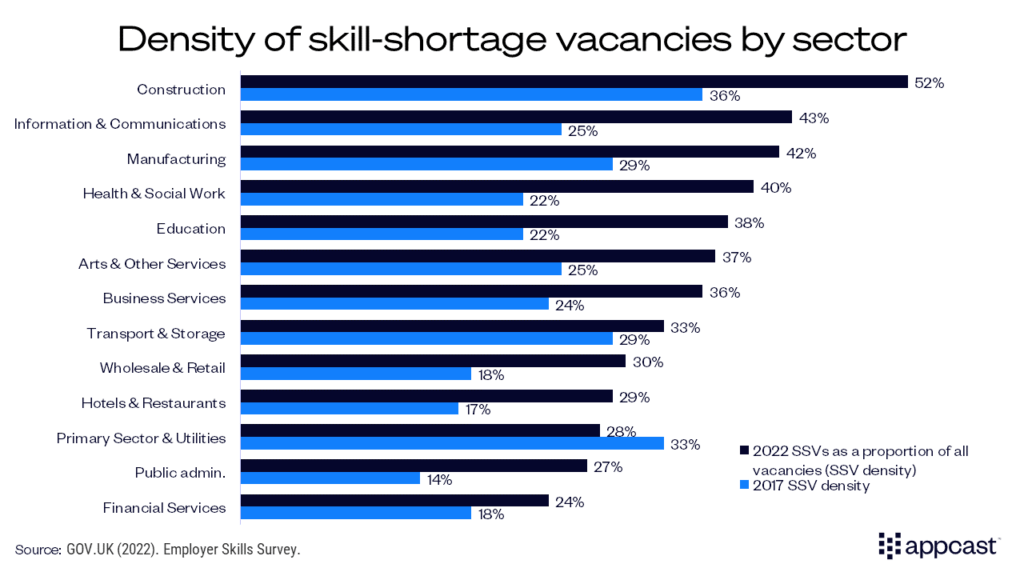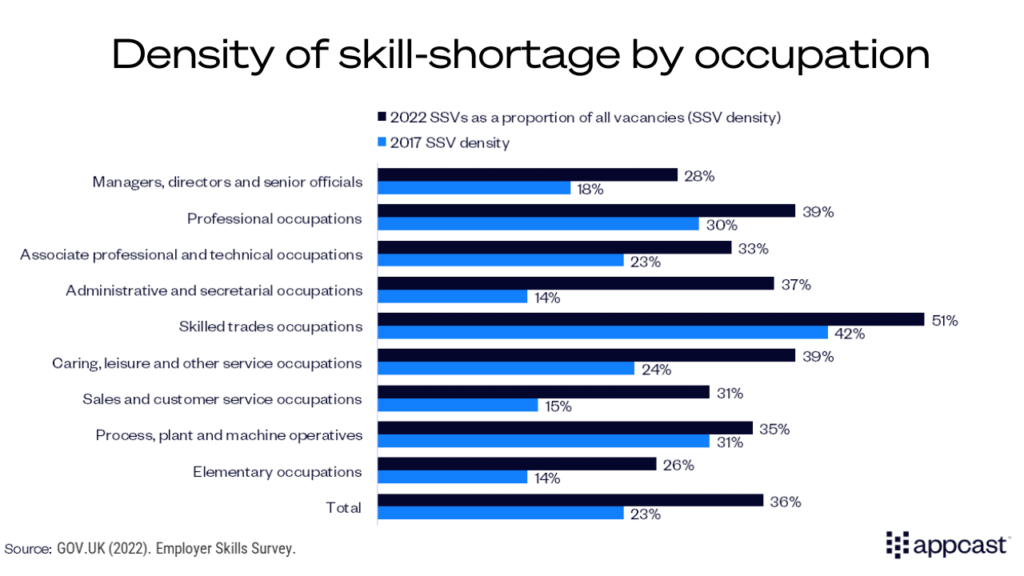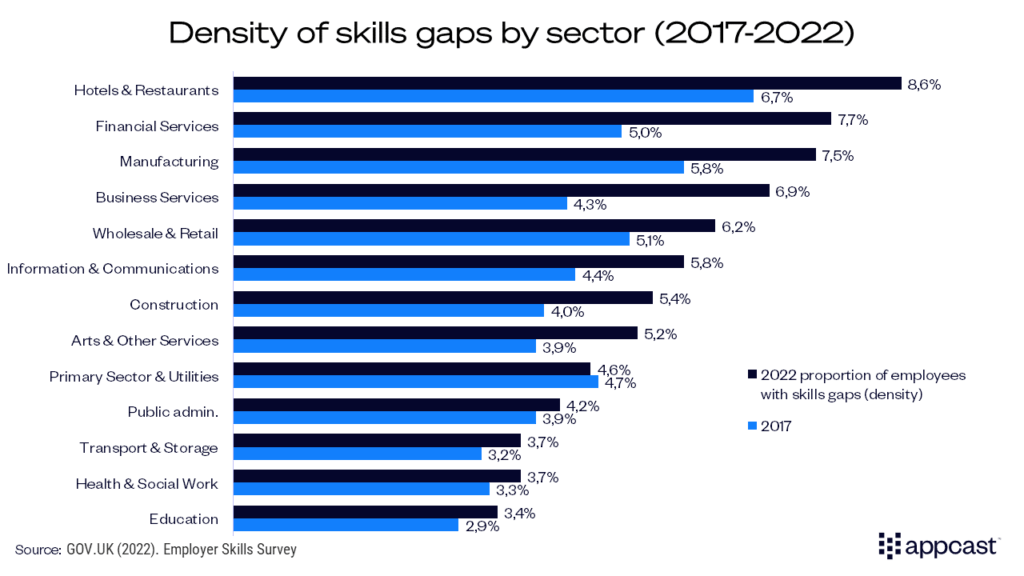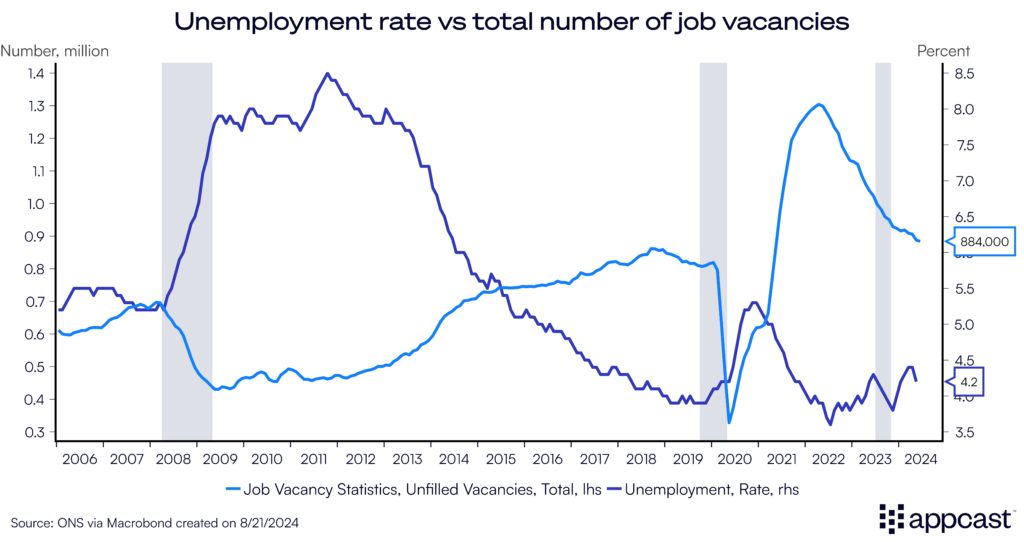The U.K. labor market remains very tight because of various economic shocks that have negatively affected labor supply. The economy has faced the economic and health shock of COVID-19, Brexit’s immigration-shrinking policies, and an aging workforce. Consequently, the gap between labor demand and supply has narrowed substantially over the last decade. As that gap shrunk and the labor market tightened, employers have found it increasingly difficult to find and hire skilled workers.
Data from the U.K.’s Employer Skills Survey shows that the number of companies with at least one hard-to-fill vacancy – those where employers report difficulties filling the role – has increased from 4% in 2011 to 15% in 2022.
The data is lagged because the survey is only published every two years, so the situation may be slightly changed since the latest release. But it still speaks to the difficulties recruiters have experienced in the past several years and continue to face.
Examples of recruitment difficulties include a low number of applicants with the required skills, a lack of interest in the job, competition from other employers and poor terms and conditions offered for the post. Skill-shortage vacancies are those where recruiters cannot find suitable candidates due to a lack of skills, qualifications, or experience among applicants
Hard-to-fill vacancies have increased from about 127,000 in 2011 to almost 850,000 in 2022, a sevenfold rise. Skill-shortage vacancies increased from a little over 90,000 to 530,000 over the same time, a sixfold increase.
The incidence of skill-shortage vacancies has risen from about 16% of all open positions in 2011 to about 36% as of 2022, indicating the severity of the problem that recruiters currently face finding the right talent.

Blue-collar sectors are more severely affected
The data from the Employer Skills Survey also provides data on skill shortages by sector and occupation. Between the 2017 and 2022 survey, the skill-shortage for vacancies increased from 36% to 52% in construction, from 29% to 42% in manufacturing, and from 17% to 29% in hotels and restaurants. The data reinforces what we have seen recently – that the skill gap is particularly severe right now in some of these blue-collar occupations (manual jobs in construction and manufacturing) since the supply of EU workers has evaporated.
Health and social work, which employs a lot of grey-collar workers like nurses, has seen the skill-shortage for vacancies increase from 22% to 40%.
Somewhat unsurprisingly, the tech sector (information and communication) stands out among white-collar industries as the one with the largest skill shortage (an increase from 25% to 43%). The recent boom in Artificial Intelligence (AI) is a factor that has contributed to higher demand for workers in tech.

If we dial in even further, to the occupation level, one can see that the skills gap has increased across the board. For managers and professionals, it rose by about 10 percentage points between 2017 and 2022.
But it is for occupations that can be classified as grey-collar work for which the skill shortage has risen the most. Administrative and secretarial work as well as sales and customer service have seen an increase of 12% and 16%, respectively. This is interesting insofar as those jobs are, according to some research, particularly vulnerable to be displaced by AI. While the effect of technological displacement may lower the total number of vacancies for such clerical jobs down the line, it could increase the skills gap if employers require future workers to be more proficient and knowledgeable in AI.

The skills gap among existing employees
Employer surveys reveal that the skills gap among existing employees has risen slightly as well. There was a slight downward trend in the years preceding the pandemic, but by 2022, employers judged that some 1.7 million employees were not fully proficient (up from 1.27 million in 2017). The proportion of employees considered to not be fully proficient by their employer increased from 4.4% to 5.7%.

Overall, 15% of employers reported skills gaps in 2022, an increase from 13% in 2017. The prevalence of the skills gap is particularly high for hotels and restaurants and stands at 8.6% (up by almost 2 percentage points). Financial services and business services have seen an even larger increase (2.7 and 2.6 percentage points), followed by manufacturing, which has the third-highest skills gap overall.
As one can see, skills gaps among existing employees are quite sector specific. It affects both blue-collar workers (hospitality and manufacturing) as well as white-collar workers (financial and business services).

Is the skills gap simply a reflection of labor market tightness?
The Employer Skills Survey has only been published every two years since 2011, with a longer discontinuation during the pandemic. While the few data points we have point towards a structural increase in skills shortages over time, cyclical factors also need to be accounted for.
2011 was generally a very weak labor market as advanced economies still suffered from the aftermath of the Global Financial Crisis. Employment was depressed, the unemployment rate was elevated at more than 8%, and the number of vacancies was depressed since hiring had frozen.
2022 was very much the opposite. The swift recovery from COVID-19 together with excessive monetary and fiscal stimulus and negative labor supply shocks due to Brexit created the tightest labor market in decades. Vacancies surged to 1.3 million, a record level, and unemployment was historically low. Recruiters therefore faced enormous difficulties filling any kind of position.

It is no wonder that in such an economic environment with demand surging across all sectors and employers aggressively competing for talent, recruiters increasingly report that there is a skills gap. In other words, the skills gap is also a function of labor market tightness and comparing the 2022 data to the data from 2011, or any other year preceding the pandemic, is difficult if there is no recognition of the exceptional labor market conditions.
Nevertheless, the gradual increase in the skills gap over time points towards structural factors like the aging workforce, and more recently, Brexit.
What does that mean for recruiters?
Data from the Employer Skills Survey points to the fact that an increasing number of recruiters are struggling to find skilled employees to fill their vacancies. This is unsurprising because the U.K. labor market has experienced several negative supply shocks related to Brexit and the pandemic. Especially skilled trades and the food and accommodation sector are struggling as the supply of workers from the EU has dried up. And the aging of the workforce is putting additional pressure on the labor market over time
At the same time, 2022 was characterized by a very tight labor market with a record number of vacancies open across all sectors as the global economy recovered quickly from the pandemic. There is no doubt that recruiters faced additional difficulties during such an extreme year as the demand for candidates soared and the competition for workers increased. The data on the skills gap from 2022 must thus be interpreted with some caution because it was sampled during a year of very high demand.
Nevertheless, long-term trends indicate that skills gaps might become even more of a challenge in the future, especially as technologies are changing rapidly with AI. Current technological change requires the need to continuously upskill and train your own employees. As a recruiter, your company can stand out and become a more attractive place of work if you can offer your staff the resources to learn and train on a regular basis.







